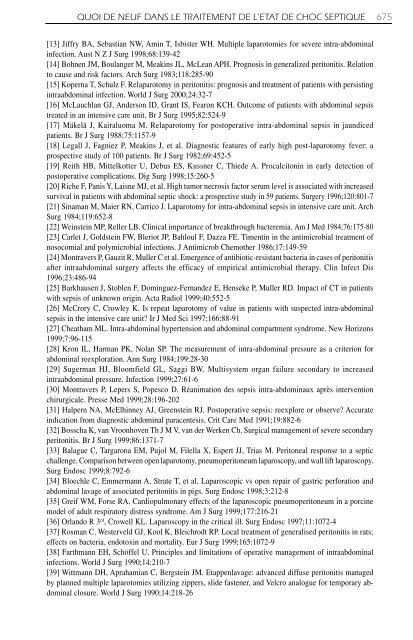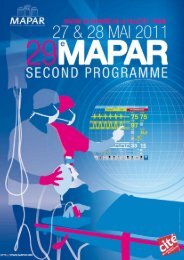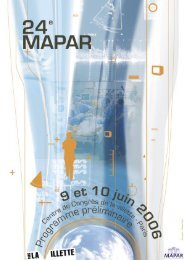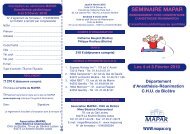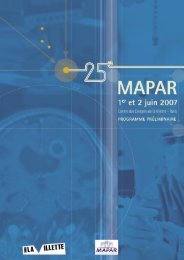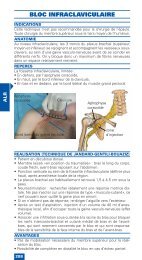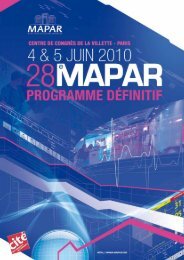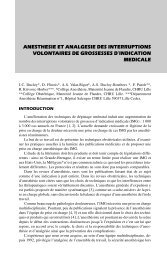LAPAROTOMIE POUR SEPSIS INTRA-ABDOMINAL - Mapar
LAPAROTOMIE POUR SEPSIS INTRA-ABDOMINAL - Mapar
LAPAROTOMIE POUR SEPSIS INTRA-ABDOMINAL - Mapar
You also want an ePaper? Increase the reach of your titles
YUMPU automatically turns print PDFs into web optimized ePapers that Google loves.
QUOI DE NEUF DANS LE TRAITEMENT DE L’ETAT DE CHOC SEPTIQUE 675<br />
[13] Jiffry BA, Sebastian NW, Amin T, Isbister WH. Multiple laparotomies for severe intra-abdominal<br />
infection. Aust N Z J Surg 1998;68:139-42<br />
[14] Bohnen JM, Boulanger M, Meakins JL, McLean APH. Prognosis in generalized peritonitis. Relation<br />
to cause and risk factors. Arch Surg 1983;118:285-90<br />
[15] Koperna T, Schulz F. Relaparotomy in peritonitis: prognosis and treatment of patients with persisting<br />
intraabdominal infection. World J Surg 2000;24:32-7<br />
[16] McLauchlan GJ, Anderson ID, Grant IS, Fearon KCH. Outcome of patients with abdominal sepsis<br />
treated in an intensive care unit. Br J Surg 1995;82:524-9<br />
[17] Mäkelä J, Kairaluoma M. Relaparotomy for postoperative intra-abdominal sepsis in jaundiced<br />
patients. Br J Surg 1988;75:1157-9<br />
[18] Legall J, Fagniez P, Meakins J, et al. Diagnostic features of early high post-laparotomy fever: a<br />
prospective study of 100 patients. Br J Surg 1982;69:452-5<br />
[19] Reith HB, Mittelkotter U, Debus ES, Kussner C, Thiede A. Procalcitonin in early detection of<br />
postoperative complications. Dig Surg 1998;15:260-5<br />
[20] Riche F, Panis Y, Laisne MJ, et al. High tumor necrosis factor serum level is associated with increased<br />
survival in patients with abdominal septic shock: a prospective study in 59 patients. Surgery 1996;120:801-7<br />
[21] Sinaman M, Maier RN, Carrico J. Laparotomy for intra-abdominal sepsis in intensive care unit. Arch<br />
Surg 1984;119:652-8<br />
[22] Weinstein MP, Reller LB. Clinical importance of breakthrough bacteremia. Am J Med 1984;76:175-80<br />
[23] Carlet J, Goldstein FW, Bleriot JP, Bahloul F, Dazza FE. Timentin in the antimicrobial treatment of<br />
nosocomial and polymicrobial infections. J Antimicrob Chemother 1986;17:149-59<br />
[24] Montravers P, Gauzit R, Muller C et al. Emergence of antibiotic-resistant bacteria in cases of peritonitis<br />
after intraabdominal surgery affects the efficacy of empirical antimicrobial therapy. Clin Infect Dis<br />
1996;23:486-94<br />
[25] Barkhausen J, Stoblen F, Dominguez-Fernandez E, Henseke P, Muller RD. Impact of CT in patients<br />
with sepsis of unknown origin. Acta Radiol 1999;40:552-5<br />
[26] McCrory C, Crowley K. Is repeat laparotomy of value in patients with suspected intra-abdominal<br />
sepsis in the intensive care unit? Ir J Med Sci 1997;166:88-91<br />
[27] Cheatham ML. Intra-abdominal hypertension and abdominal compartment syndrome. New Horizons<br />
1999;7:96-115<br />
[28] Kron IL, Harman PK, Nolan SP. The measurement of intra-abdominal pressure as a criterion for<br />
abdominal reexploration. Ann Surg 1984;199:28-30<br />
[29] Sugerman HJ, Bloomfield GL, Saggi BW. Multisystem organ failure secondary to increased<br />
intraabdominal pressure. Infection 1999;27:61-6<br />
[30] Montravers P, Lepers S, Popesco D. Réanimation des sepsis intra-abdominaux après intervention<br />
chirurgicale. Presse Med 1999;28:196-202<br />
[31] Halpern NA, McElhinney AJ, Greenstein RJ. Postoperative sepsis: reexplore or observe? Accurate<br />
indication from diagnostic abdominal paracentesis. Crit Care Med 1991;19:882-6<br />
[32] Bosscha K, van Vroonhoven Th J M V, van der Werken Ch. Surgical management of severe secondary<br />
peritonitis. Br J Surg 1999;86:1371-7<br />
[33] Balague C, Targarona EM, Pujol M, Filella X, Espert JJ, Trias M. Peritoneal response to a septic<br />
challenge. Comparison between open laparotomy, pneumoperitoneum laparoscopy, and wall lift laparoscopy.<br />
Surg Endosc 1999;8:792-6<br />
[34] Bloechle C, Emmermann A, Strate T, et al. Laparoscopic vs open repair of gastric perforation and<br />
abdominal lavage of associated peritonitis in pigs. Surg Endosc 1998;3:212-8<br />
[35] Greif WM, Forse RA. Cardiopulmonary effects of the laparoscopic pneumoperitoneum in a porcine<br />
model of adult respiratory distress syndrome. Am J Surg 1999;177:216-21<br />
[36] Orlando R 3 rd , Crowell KL. Laparoscopy in the critical ill. Surg Endosc 1997;11:1072-4<br />
[37] Rosman C, Westerveld GJ, Kool K, Bleichrodt RP. Local treatment of generalised peritonitis in rats;<br />
effects on bacteria, endotoxin and mortality. Eur J Surg 1999;165:1072-9<br />
[38] Farthmann EH, Schöffel U. Principles and limitations of operative management of intraabdominal<br />
infections. World J Surg 1990;14:210-7<br />
[39] Wittmann DH, Aprahamian C, Bergstein JM. Etappenlavage: advanced diffuse peritonitis managed<br />
by planned multiple laparotomies utilizing zippers, slide fastener, and Velcro analogue for temporary abdominal<br />
closure. World J Surg 1990;14:218-26


